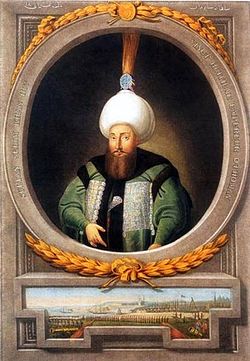- Nizam-ı Cedid
-
Military of the
Ottoman EmpireArmy: Sipahi · Akıncı · Timariot · Janissary · Nizam-ı Cedid · Mansure Army · Navy · Military aviation Conflicts: European · Near East · Byzantine · Croatian · Austrian · Persian · Polish · Russian · Serbian · Venetian · Portuguese · Sieges and landings · Battles · Cities conquered
Conflicts: European · Near East · Byzantine · Croatian · Austrian · Persian · Polish · Russian · Serbian · Venetian · Portuguese · Sieges and landings · Battles · Cities conqueredThe Nizam-ı Cedid (from Arabic َAl-Niẓām Al-Jadīd via Persian Nizām-e Jadīd - "New Order") was a series of reforms carried out by the Ottoman Empire sultan Selim III during the late eighteenth century in a drive to catch up militarily and politically with the Western Powers. Specific reforms included conscription, new taxes, new legal categories, and the promotion of a more territorially-based state structure achieved by more strictly defined regions and administrative centralization.[1] The term later came to refer to the new regular army established under the reform program.
European states welcomed such reforms as useful for their imperial agenda and efforts to civilize colonial holdings. Both the French and the British sent military instructors to the reorganized Muslim regimes; they also sold them artillery. Conversely, some domestic Muslims criticized the reforms as infidel importations. The reformers countered that the reforms were new armies that could be used to defend the Muslim world from European crusades and other invasions.[1]
Conditions
Between 1829 and 1855 the new army was constantly being improved under the sight of military advisors. The troops of the Nizam-ı Cedid corps were equipped with European-style uniforms and educated in European military strategy. The Sultan made sure that, if the campaign of 1829 against the Russians was fought over again in 1855, the result would be very different.
Footnote
- ^ Section based on the article by THE INTERNATIONAL MAGAZINE 1855.
References
Categories:- Military history of the Ottoman Empire
- Politics of the Ottoman Empire
- Military units and formations of the Ottoman Empire
- 1842 establishments
Wikimedia Foundation. 2010.

